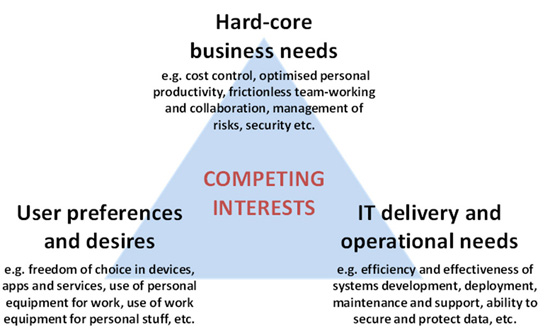Much has been written about the rise of user influence and power. Some of it might exaggerate the degree to which phenomena such BYOD and shadow IT now define the state of play, but there is no denying the trends. Our research (and others’) consistently tells us that more demanding and less tolerant employees are increasing challenging the IT status quo, and in some cases are bypassing (or attempting to circumvent) IT policies and processes. Most organisations are seeing at least some of this kind of behaviour, particularly in parts of the business that have more political power.
Some commentators interpret the trends as an indicator of IT departments failing to ‘get’ how needs are evolving within the business. The assertion is that CIOs and their teams are stuck in their old ‘command and control’ ways of thinking, and are unwilling or unable to adjust to the new world of cloud and mobile. Meanwhile, tech-savvy employees educated through the use of technology and services in their personal lives don’t suffer from the same baggage, which today puts them in a better position than IT to decide what’s optimal for the business. It’s even argued that IT teams will become redundant over time, or maybe relegated to just looking after the ‘plumbing’, as users drive the things that really matter in collaboration with external providers who offer more flexibility.
It’s a compelling narrative, and a great one to propagate if you are into sensationalist mischief-making. But like most things in IT and business, the reality is a little more complicated.
The truth is that unilateral user activity is not always a function of business need. Sure, when an employee starts using a personal device or consumer cloud service for business purposes they may be highlighting a capability gap that needs to be addressed. But such ‘BYO’ adoption of solutions could equally be down to the user simply acting on a personal preference or interest, following fashion, or attempting to demonstrate their status or individuality.
Even if BYO activity reflects a genuine business requirement, users are generally not great at looking beyond their own immediate needs and wants. With a frequently parochial perspective, bigger picture considerations such as security, compliance, data protection, future-proofing, interoperability, maintenance and support often don’t figure that highly in their thinking, if at all. And in opting to use something different to their colleagues, they may create more productivity problems than they solve as a result of limitations and incompatibilities that need to be worked around by everyone else, as well as themselves.
So users gaining more of a voice and assuming more power is a mixed blessing if such developments are allowed to take place in a free-wheeling manner. Handled appropriately, however, with the right level of input, guidance and control from IT (yes ‘control’ is NOT a dirty word), the business can potentially benefit more quickly from new ideas and ways of working.
When working through the practicalities, a trick we recommend is to keep the ‘triangle of interests’ in mind (Figure 1).

Figure 1 – The triangle of competing interest
For progress to be made and harmony gained or maintained, it is critical that both IT and business stakeholders work through the different sets of interests together when considering a new idea, requirement or problem to be dealt with. Of course when conflicts arise, it’s the hard-core business interests that must be prioritised over the other two.
Putting this into practice, which basically translates to updating your IT governance processes to deal with an increased level of user input, is easier said than done, but it’s critical if the business is going to get the best from technology in an increasingly digital world, and various proven approaches exist that can adopted.
If you are interested in some more detailed advice and guidance on this, we would encourage you to download our paper entitled: “IT-Business Alignment Revisited: Accommodating increased user influence”. You can get hold of your copy from the Freeform Dynamics website by clicking here.
CLICK HERE TO VIEW ORIGINAL PUBLISHED ON
